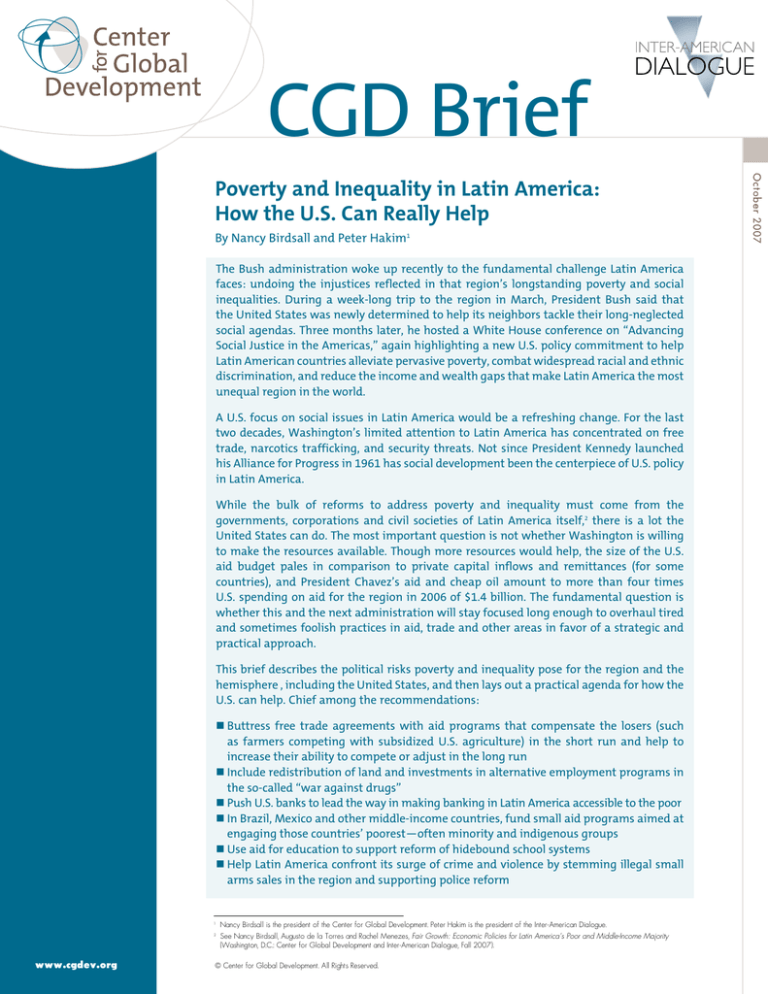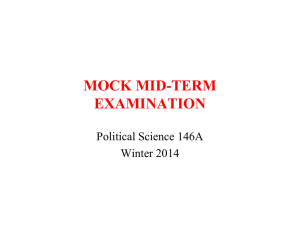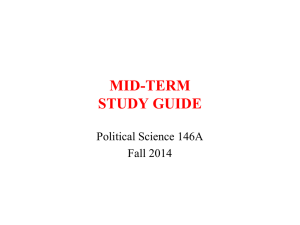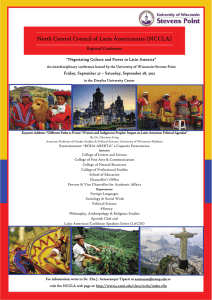
CGD Brief
By Nancy Birdsall and Peter Hakim1
The Bush administration woke up recently to the fundamental challenge Latin America
faces: undoing the injustices reflected in that region’s longstanding poverty and social
inequalities. During a week-long trip to the region in March, President Bush said that
the United States was newly determined to help its neighbors tackle their long-neglected
social agendas. Three months later, he hosted a White House conference on “Advancing
Social Justice in the Americas,” again highlighting a new U.S. policy commitment to help
Latin American countries alleviate pervasive poverty, combat widespread racial and ethnic
discrimination, and reduce the income and wealth gaps that make Latin America the most
unequal region in the world.
A U.S. focus on social issues in Latin America would be a refreshing change. For the last
two decades, Washington’s limited attention to Latin America has concentrated on free
trade, narcotics trafficking, and security threats. Not since President Kennedy launched
his Alliance for Progress in 1961 has social development been the centerpiece of U.S. policy
in Latin America.
While the bulk of reforms to address poverty and inequality must come from the
governments, corporations and civil societies of Latin America itself,2 there is a lot the
United States can do. The most important question is not whether Washington is willing
to make the resources available. Though more resources would help, the size of the U.S.
aid budget pales in comparison to private capital inflows and remittances (for some
countries), and President Chavez’s aid and cheap oil amount to more than four times
U.S. spending on aid for the region in 2006 of $1.4 billion. The fundamental question is
whether this and the next administration will stay focused long enough to overhaul tired
and sometimes foolish practices in aid, trade and other areas in favor of a strategic and
practical approach.
This brief describes the political risks poverty and inequality pose for the region and the
hemisphere , including the United States, and then lays out a practical agenda for how the
U.S. can help. Chief among the recommendations:
nButtress free trade agreements with aid programs that compensate the losers (such
as farmers competing with subsidized U.S. agriculture) in the short run and help to
increase their ability to compete or adjust in the long run
nInclude redistribution of land and investments in alternative employment programs in
the so-called “war against drugs”
nPush U.S. banks to lead the way in making banking in Latin America accessible to the poor nIn Brazil, Mexico and other middle-income countries, fund small aid programs aimed at
engaging those countries’ poorest—often minority and indigenous groups
nUse aid for education to support reform of hidebound school systems
nHelp Latin America confront its surge of crime and violence by stemming illegal small
arms sales in the region and supporting police reform
Nancy Birdsall is the president of the Center for Global Development. Peter Hakim is the president of the Inter-American Dialogue.
See Nancy Birdsall, Augusto de la Torres and Rachel Menezes, Fair Growth: Economic Policies for Latin America’s Poor and Middle-Income Majority
(Washington, D.C.: Center for Global Development and Inter-American Dialogue, Fall 2007).
1
2
www.cgdev.org
© Center for Global Development. All Rights Reserved.
October 2007
Poverty and Inequality in Latin America:
How the U.S. Can Really Help
Poverty and Inequality in Latin America: How the U.S. Can Really Help
Poverty and Inequality in Latin America—
and its Consequences
With his vitriolic campaign to oppose the United States and
install “21st century socialism” in Latin America, Venezuela’s
firebrand President Hugo Chavez has demonstrated how
deeply the call for social justice resonates across the region.
Nearly 20 years of U.S.-backed economic and trade reforms
may have enjoyed some successes: reducing inflation (the single greatest tax on the poor), dismantling patronage-ridden
state enterprises, and providing the macroeconomic stability
that has enabled the region to benefit from the booming global
markets in food and mineral exports—soybeans, cotton, coffee, nickel, copper and a range of other commodities. But even
with the resulting surge of growth, some 40 percent of Latin
America’s citizens still live in poverty, a figure that has changed
little in the past quarter century. Joblessness is higher in 2007
than it was in 1990, and deep inequality remains the region’s
hallmark. In most countries, less than 10 percent of the population controls more than 50 percent of the wealth—and an even
more disproportionate share of real political influence. At his
first inauguration in 1995, sociologist turned president Fernando
Henrique Cardoso said “Brazil is not an undeveloped country;
rather it is an unjust one.”
visits by a hospital ship to various Latin American ports and
increased scholarships for study in the United States—are a
feeble response. Expanded funding for home mortgage loans
and a subsequent announcement from Treasury Secretary
Paulson of a new U.S. fund to step up lending to small- and
medium-sized enterprises in Latin America are in the right
spirit—but are also small and piecemeal. Overall the recent
announcements don’t add up to anything resembling a forceful or well-considered strategy to deal with the hemisphere’s
vexing social inequalities.
Some current U.S. programs are relevant to an attack on Latin
America’s social problems; they just need to have a more visible and robust social dimension.
A New U.S. Agenda in Latin America
Trade Plus Aid: Buttressing Free Trade Agreements
With Help for the Losers
The United States should worry about who benefits (and who
does not) from the trade agreements it negotiates. Free trade
agreements are spurring exports and investment and encouraging better economic management in the region. The resulting
jobs and growth can potentially contribute to reducing poverty—but only if complementary policies ensure that the beneThe consequences of such economic and social imbalances fits are extended to excluded groups. Otherwise free trade
are high: many Latin Americans feel alienated from their own can end up mostly serving the economically better-off, while
leaders and uneasy about “markets” and “globalization.” others fall behind and income disparities widen.
Politics have become polarized in country after country, making it harder to govern and increasing the prospects of internal The United States has reached bilateral trade deals with 11 Latin
conflict. The U.S. is widely seen as defending its own narrow American countries3 (three still require U.S. congressional approval).
commercial interests in the region, as the champion of market But according to even their strongest supporters, the terms of the
reforms that have failed to help the poor—and as wholly agreements have been inflexible and tight-fisted. The United
indifferent to Latin America’s social and political ­tensions. This States, for instance, over the objections of every government in
has
contributed
to
deep
and
widespread the region, continues to restrict exports of agricultural products,
anti-U.S. sentiment. In these circumstances it is no surprise that especially sugar, and to limit apparel exports through burdensome
Latin Americans are electing leaders who promise an alterna- rules of origin.4 At the same time, the United States resists any
tive to U.S.-backed policies. Last year, supporters of Hugo reduction in its support for hugely subsidized grain products, which
Chavez won presidential elections in Bolivia, Ecuador and are displacing the corn and rice sold by Latin America’s unsubsiNicaragua. A small shift in voter sentiment might well have dized and un-mechanized peasant producers.
given Chavez new allies in the larger and more influential
countries of Mexico and Peru. In all these countries, dema- A better U.S. trade policy in Latin America should aim to
gogic politics and populist leaders threaten to undo the fiscal increase the number of winners from the bilateral trade agreeand other reforms implemented in the last two decades that ments it negotiates, and ensure that potential losers are comhave been, while not always perfect, an important step pensated in one way or another. To increase the number of
towards making life better for the region’s majority.
winners agreements should include U.S. financing for the training of workers and technical assistance to small firms—a
Meanwhile, the United States has not begun to match the form of trade adjustment assistance to trading partners.
thought, energy or resources Hugo Chavez is investing in the Reducing the number of losers requires that the U.S. governsocial agenda. The Bush administration’s initial proposals— ment stand down big agribusiness, pharmaceutical and other
Chronologically (by completion of negotiations) they are Mexico, Chile, Costa Rica, the Dominican Republic, El Salvador, Guatemala, Honduras, Nicaragua, Peru, Colombia and Panama (although the
last three still require congressional ratification).
4
See Kimberly Elliott, Pitfalls in Asymmetric Negotiations, CGD “Have a View” (Washington, D.C.: Center for Global Development, 2006).
3
In addition and in the meantime, the United States can more
explicitly ensure its foreign aid programs reach small farmers
in the region (who, without resources and technical inputs,
have been losing out from trade openings) by using aid to
compensate them for the competitive advantage American
farmers get from subsidies, tariffs and other barriers. Aid programs should also support trading partners’ efforts to increase
agricultural productivity. And why not extend trade-related
programs to countries that have not yet signed bilateral trade
agreements with the United States, as long as they are showing a commitment in their own expenditures to education,
health and other programs that ensure the benefits of more
open trade markets will likely be captured by the majority
of citizens?
The European Union (EU) has some experience with financial
transfers to its poorest members, which were designed to
reduce economic differentials among member countries. In the
late 1990s, the EU’s net fiscal transfers to Spain alone were
more than $4 billion a year, while transfers to Poland in the
next five years will amount to upwards of $10 billion a year.
U.S. funding specifically linked to ensuring that the benefits of
trade are widely shared could be much smaller ($500 million
a year for the entire region would be a good start), and
would signal U.S. interest, not in free trade per se, but in
greater and more inclusive growth in the region. In short, to
advance Latin America’s social agenda, Washington should
replace its “trade, not aid” slogan with “trade plus aid.”
From a War Against Drugs to a War Against Poverty:
Land and Jobs in Coca-Growing Regions
More than one-half of all U.S. “aid” to Latin America (about
$750 million of $1.4 billion in 2006) supports Washington’s
anti-drug campaign in the Andean region, predominantly in
Colombia. The eradication of coca plants has long been the
mainstay of this effort, but eradication, by itself, cannot produce lasting results, since no matter how much of the coca
crop is eliminated, small coca-growing farmers will return to
coca cultivation when they cannot find other sources of
employment. The failures of U.S. policy are most obvious in
Bolivia, where the singular focus on coca eradication contrib-
uted to loss of employment and livelihoods and to growing
resentment in rural areas, helping to elect President Evo
Morales—so far an ally of Chavez in spirit and rhetoric if not
fully in practice.
The United States should shift funds away from the singular
(and unrealistic) goal of coca eradication toward development and job creation in coca growing regions. And there
are viable alternatives. The rapid growth of flower exports
from Colombia and Ecuador, and asparagus production in
Peru, illustrate the potential benefits of a focus on rural development. In Colombia, the United States has finally begun shifting a share of its anti-drug support toward rural development. But much more could be done there and in Bolivia—including
comprehensive programs of land distribution and rural
enterprise development targeted to indigenous and other
landless peoples.
Bank the Unbanked: Making the Poor
Bank Customers Remittances—sent mostly from low-income migrants in the
United States to their relatives back home—are now Latin
America’s largest source of external capital. The $60 billionplus of annual remittances are 40 times the U.S. aid program in
the region, and are making a huge dent in rural and urban poverty. The United States government ought to make it official
policy to enhance the social impact of remittances. One step
would be for U.S. Treasury officials to use their bully pulpit—
pressing the financial community to encourage U.S.-based senders and Latin-based receivers to open banks accounts and
facilitate the process. The immediate payoff is lowered costs
for sending remittances, putting more money in the hands of
recipients. Over time, a bank account gives its owner a range
of new financial opportunities (direct deposit, free check cashing, credit-worthiness, etc.). Few initiatives would do more to
diminish poverty in Latin America than a systematic effort to
expand the numbers of low-income families who use bank
accounts. Washington should take steps both to make it easier
for all U.S. residents to open accounts, and to encourage U.S.
banks to work harder to recruit migrant customers.
Private U.S. programs support micro-finance throughout the
region. The U.S. government could remind Latin American governments of the benefits of pressing their own banks to end the
long-standing presumption that banking is only for the wellheeled. After all, microfinance institutions in many nations are
making money as well as helping the poor and near-poor to
capture the benefits of becoming bank customers.
October 2007
interest groups that have traditionally hijacked trade negotiations (often disregarding the real long-term interests of even
U.S. producers and consumers). Though politically contentious,
it can be done, as suggested by the recent agreement
between the congressional leadership and the administration
to loosen the requirements for stronger intellectual property
protections if they impede policies to promote public health.
Poverty and Inequality in Latin America: How the U.S. Can Really Help
In Middle-Income Countries, Help Engage
Poor Minorities
Help Latin America Deal with its Wave of Crime
and Violence
Most of Latin America’s poor live in middle-income countries
which no longer receive large infusions of foreign aid from
any major donors. For example, the Millennium Challenge
Account, an innovative U.S. foreign assistance program
established by the Bush administration in 2004, will serve no
more than five or six of Latin America’s smallest and poorest
countries—which together account for less than 5 percent of
the region’s poverty-stricken families. In other countries, U.S.
aid need not be massive. It just needs to be smart. In Southern
Mexico and Northeast Brazil, the United States should
concentrate on developing and supporting local innovations
designed to reach and engage the poor, supporting and
developing ways to reach poor and ­vulnerable populations,
including Afro-descendants and indigenous groups.5
Crime is as devastating to the poor in Latin America as unemployment and discrimination. Latin America leads the world in
kidnappings. Its homicide rate is twice the global average.
Youth gangs have thrown several Central American countries
into turmoil. Mexico is using its army to battle narcotics dealers and corrupt police. Brazil’s two largest cities, Sao Paulo
and Rio de Janeiro, have been terrorized by drug gangs.
Everywhere, it is the poor that bear the brunt of this pervasive
and escalating criminal violence, which is aggravated in many
places by the corruption, disarray and inadequate financing of
police forces and judicial systems.
Some of this is already being done. For example, the InterAmerican Foundation, a small and little-known U.S. government program, provides small grants directly to the poor in
nearly every Latin American country. Such programs generate the learning about what works that local governments
can then imitate and extend. Given its success over many
years, the United States should scale up the Foundation’s
funding and activities. The Bush administration should also
welcome Senator Robert Menendez’s (D-NJ) imaginative
proposal, soon to be introduced as legislation, to establish
a Latin American-wide social development fund that would
pool resources from the countries of the region with those
of the United States and Canada and the multilateral development agencies.
Support Reform and Innovation in Hidebound
School Systems The dismal quality of education remains the Achilles’ heel of
economic and social development virtually everywhere in
Latin America, despite significantly increased spending on
schooling in the last two decades. In country after country,
governments are failing to overcome hidebound regulations,
rigid educational bureaucracies, self-serving unions, and
regressive expenditure patterns. U.S. funding for education
should go to the champions of serious school reform in the
region, and should promote innovation and flexibility to
generate the demonstration effect that would make an
important difference.
Washington can best help Latin American countries stem the tide
of crime by pushing the World Bank and the Inter- American
Development Bank to work with countries on police reform.
Signing on to the U.N. protocol on small arms trafficking would
also help by at least signaling serious concern. Finally, the United
States should end its practice of deporting convicted felons to
their countries of origin, regardless of how long they have resided
in the United States. These deportees today lead the vicious
youth gangs that have become so destructive.
Conclusion: Advancing Latin America’s
Social Agenda Serves U.S. Interests Right now, Washington seems to be losing Latin America. A
coherent set of robust initiatives to help Latin America confront
its social needs and economic divisions could start a healthy
process of rebuilding the United States’ lost trust and influence—which is in the interest of the U.S. as well as the
region’s poor majority. Latin America is much less reliant on
the United States than it used to be and may need its good
neighbors to the south more than vice versa in the new geostrategic environment of this century. For more on how and
why that is the case, and on how the many aspects of U.S.
official behavior –from the war in Iraq, to immigration, the
drug war, and sometimes overbearing diplomatic style—affect
America’s image in the region, see Losing Latin America.
Of course even an ideal set of U.S. policies and programs—
in aid, trade, immigration, and crime and drug control—could
not possibly, alone, do much to transform the lives of Latin
America’s poor.6 In the end it is not Washington but the
region’s own governments, corporations, and civil societies
that will matter most. Fortunately, however, Latin America is
more democratic and its governments more competent and
responsible than two decades ago. Today more than ever the
most important outcome of a robust U.S. strategy to support
inclusive growth may not be what it accomplishes, but what it
encourages the countries themselves to do.
A good example of the importance of engaging vulnerable populations is girls education. A 2007 CGD book found that nearly three-quarters of the 60 million girls not in school in developing countries
belong to ethnic, religious, linguistic, racial and other minorities. For more see Maureen Lewis and Marlaine Lockheed, Inexcusable Absence: Why 60 million girls still aren’t in school and what to do about it
(Washington D.C.: Center for Global Development, 2007).
6
Nancy Birdsall and Rachel Menezes, Toward a New Social Contract in Latin America, CGD Brief (Washington, D.C.: Center for Global Development, December 2004).
5
Losing Latin America
U.S. influence and credibility has badly waned in Latin America. Washington’s bad policy choices are mostly to blame.
To be sure, as Latin American countries reformed and opened their economies and strengthened their democracies, they
inevitably became more and more integrated into world financial and political networks, less reliant on the United States
and less willing to routinely accept U.S. leadership. What was not inevitable was the growing distrust of Washington in
the region and the rapid upsurge of anti-American sentiment—consequences mostly of the Iraq invasion and the subsequent
conduct of the war. The combination of brutality and failure has been disastrous for Washington’s image in a region long
wary of U.S. power.
But U.S. policies in the hemisphere also bear blame. With the United States so totally absorbed in the Middle East, the Bush
administration has been unresponsive to Latin America. And when it has tried to engage, it has often been either ineffectual
or overbearing and uncompromising.
Mexicans and Central Americans, for example, were dismayed by President Bush’s failure to deliver on his promise to
make U.S. immigration practices less punitive and more welcoming. Trade policy has been an area of some success for the
Bush administration, but the rigidity of U.S. negotiating positions have rankled even the strongest proponents of free trade.
The United States remains out of step with the great majority of Latin American countries on several other key issues, most
importantly, on Cuba and anti-drug policy.
In addition, Latin Americans often bristle at the style of U.S. diplomacy and politics—and the attitudes that underlie them.
With some justification, they feel that Washington still views the region as its backyard and expects governments there
to consistently follow the U.S. lead.
Latin America will not be a foreign policy priority for the next U.S. president. It will not be a central front in the war on
terrorism. Nor is Latin America expected to offer the oversized economic opportunities of rapidly growing China and
India. Illicit drugs and undocumented immigration are important issues, but they are long-standing, contentious problems that
have mostly divided the United States from the region. The challenge for Washington is how to conduct a constructive
and cooperative policy toward Latin America while the region remains a relatively low priority—and U.S. influence in the
region is at a low ebb.
Washington’s first task will be to demonstrate renewed respect for international rules and institutions. The United States
cannot be seen as high-handed. It cannot claim the right to invade other countries preemptively or make decisions
unilaterally against a consensus of other nations. The United States needs to play by the rules it wants others to follow.
Second, Washington’s policies, while serving U.S. interests, have to be more relevant to Latin America’s own needs for
faster and more stable growth, a sustained reduction in poverty and inequality, and progress against a seemingly endless
wave of crime and violence.
What Latin American nations mainly want from Washington is greater access to U.S. markets, investment capital, and
new technologies. The White House’s most important challenge is to fashion a bipartisan approach to regional economic
and trade policy.
October 2007
By Peter Hakim







